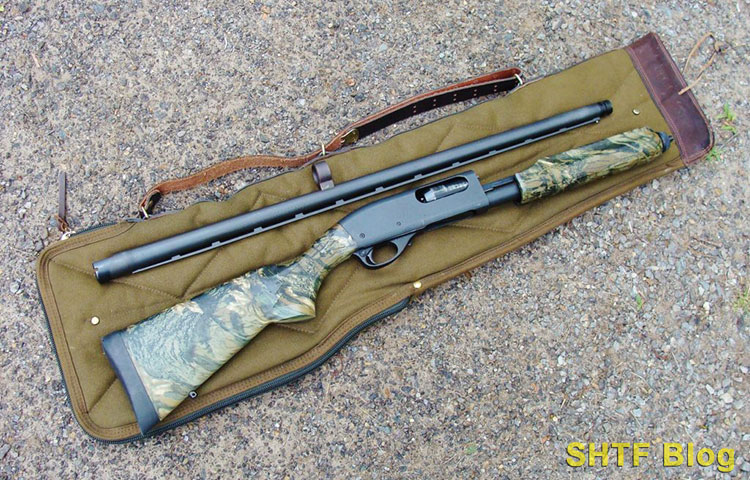
It’s widely accepted that a shotgun is the best all-purpose firearm a homeowner can have. This applies to homesteads too. But if you could only choose one, what would be the best shotgun for homesteaders?
Let’s look into the details…
Maximum Versatility – Minimal Cost
As I’ve noted before, “the gun that won the west” was actually a plain-Jane scattergun. Costing less than a lever-action rifle, for most, they offered greater versatility. Birdshot shells could keep the larder stocked with small game, upland birds, or waterfowl. Back then, the shotgun was the best gun for survival.
Larger quarry like deer could be harvested with buckshot or, sometimes, “pumpkin balls.” The same loads could also cover defense inside around 40 paces. A rifle was sometimes added to cover longer-range needs, but on a day-to-day basis, a shotgun ruled the roost for homesteaders.
The most affordable type of shotgun was (and still is) a basic, break-action, single-shot. Although fine for eliminating unwelcome crop raiders, all have an Achilles Heel – just one shot, which compromises defensive.
Due to its one-shot limitation, we will examine repeating shotguns – again with an eye toward reasonable cost and maximized versatility.
Until early in the 20th century, double-barreled shotguns were the answer for those seeking greater firepower. The appearance of repeaters quickly shifted that trend. Semiautomatics (also known as autoloaders) were new-fangled and less shell-tolerant, but slide-action designs (pumps) could readily digest paper-hulled shells of that era, and they were also less expensive.
Within a relatively short period of time the pump-gun was king. A century later, it’s still hugely popular thanks to proven designs within easy financial reach of most.
Regarding chamberings, the 12 gauge is by far the most popular. The 12 gauge, for those with smaller statures or who shoot all day, a sore shoulder can result, but there are ways to reduce shotgun recoil. If those don’t work, the 12 gauge is followed by the smaller but still effective 20 gauge. More information about gauges, loads, and chokes can be found in the first installment.
Remington Model 870 Practical Pump Shotgun
Today’s double-guns are expensive sporting propositions with the exception of a few lower-grade imports, sometimes marketed more for home defense. On the other hand, pump action guns offer three or more quick shots with true sporting and defensive capabilities.
And, unlike semiautos dependent on specific pressure parameters, they’re not fussy about their diets. The icing on the cake is lower cost. Among several prominent brands from Benelli, Browning, FN, Winchester (and a few others), the two major players are Mossberg and Remington.
The single best shotgun for homesteaders is the Remington Model 870 Express with two barrels.
The majority of my pump-gun experience involves Remington’s iconic Model 870. Thus, it’ll serve as the frame of reference. However, many of the comments that follow will apply to other good guns. If the strategy that follows has value, research spare barrel options before committing to a purchase.
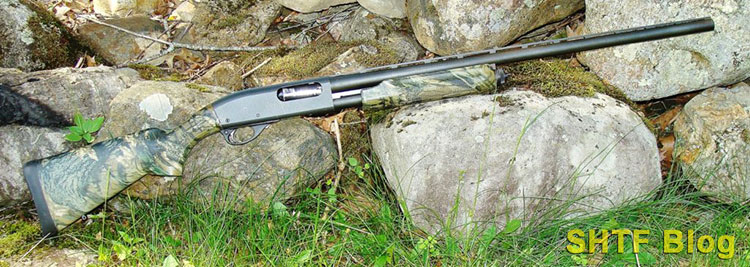
Model 870 Examples
Until recently, I inventoried dozens of Remington M-870 “police” shotguns, which quite literally digested tons of 12 gauge shells, the majority being slugs or buckshot. These were agency guns that led a hard life. Still, problems were remarkably few despite decades of use.
The same guns are still going strong today! In fact, the Model 870 has been in production since 1950, with around 11 million sold.
Manufacturing was interrupted in late 2020 when “America’s Oldest Gun Maker” shut down due to business woes. Fortunately, Remington is now under new management. As of mid-May 2021, the old Ilion, NY plant has begun rehiring workers via an ambitious schedule. Initial focus? The Model 870! Present unknowns include variations and pricing.
Meanwhile, there are plenty of Remington 870s in circulation, along with lots of parts and accessories.
Pre-pandemic cost of new Remington Model 870 Express was around $350. This plain-Jane version of the prettier Model 870 Wingmaster will no doubt make an early reappearance. A 12 or 20 gauge Express with a 26-28-inch ventilated-rib barrel makes a good general-purpose choice.
These guns are supplied with a removeable choke-tube (modified) and chambered to fire 2 ¾ or 3” shells. They have a bead-blasted, blued- steel finish, and a hardwood or black synthetic stock. Capacity is 4 +1, meaning the magazine-tube will accommodate four shells.
Although right and left-handed versions exist, a right-handed gun can work for either group, and the safety is easily reversible.
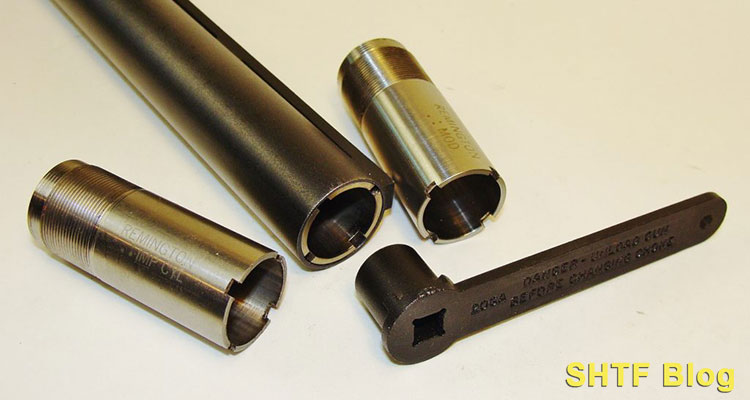
Other configurations included a brutal 12 gauge 3 ½” Magnum (more power than normally needed). There are also shorter-barreled defensive guns, and even an extra-short model sans a conventional stock that resembles an ugly banana.
Another rage is the detachable-magazine version geared for defense. Truthfully though, a basic sporting-type gun is much more versatile. If necessary, practical defensive upgrades can be added later for little additional expense.
Meanwhile, you’ll own a good general-purpose shotgun with excellent handling qualities capable of taking everything from squirrels through geese. Extra Rem-Choke tubes are available, including very tight versions for use on turkeys.
The M-870 is so widely distributed that lots of accessories are available. One worth having is a sling. The wood-stocked guns will likely require installation of an after-market QD stud. A stud-equipped magazine cap will permit attachment of the forward QD sling swivel.
And, that forend cap can help morph your pedestrian bird-gun into an effective big game/defensive firearm. The transition is much easier for those who can resist the urge to add an extended magazine.
Big Game/Defensive Capability
The key to fast disassembly of an 870 (and some others) is its threaded magazine cap. The bolt locks securely into battery via a reciprocating steel lug that engages an integral extension of the barrel. After opening the slide a bit (using the slide-release tab), these parts will disengage.
The magazine cap can then be unscrewed, allowing removal of the barrel through a forward tug. This design facilitates a near-instantaneous barrel exchange for exceptional versatility.
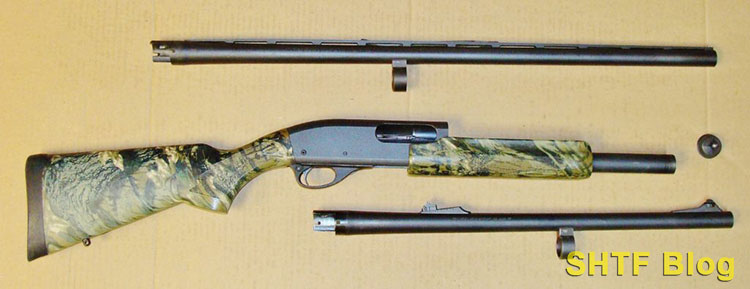
Rifle-sighted Slug Barrel
Add one and you’ll gain a formidable close-range big game “rifle” or defensive weapon. Skip the bead-equipped barrel intended strictly for close-range defense. An adjustable rifle-sight smooth-bore version will permit effective delivery of basic lead Foster-type rifled slugs right out to 75 yards or beyond; well worth the minor additional cost. FYI, plenty of used barrels are in circulation.
Slug Notes
Having witnessed the discharge of thousands of Winchester Super-X one-ounce 12 Gauge slugs (#X12RS15) from a bunch of these barrels, it’s a safe bet yours can place five within a 3-inch circle at 50 yards. And, a .73-caliber one-ounce bullet (437 grains) that starts out above 1500 fps is nothing to take lightly.
It’ll handle everything in North America from cars to cows (seen both, and yes, you can eat crow). Fancier sabot-type slugs are available for use in rifled barrels but the meat & potato Winchesters will work fine for much less cost (around $5 per box of five). The downside is, they kick like the Dickens.
There are several “low-recoil” alternatives that launch with less velocity but, in our experience, the WW 2 ¾” Super-X is usually more accurate. We have no interest in any 3” Magnum versions, given their increased recoil and modest velocity gains.
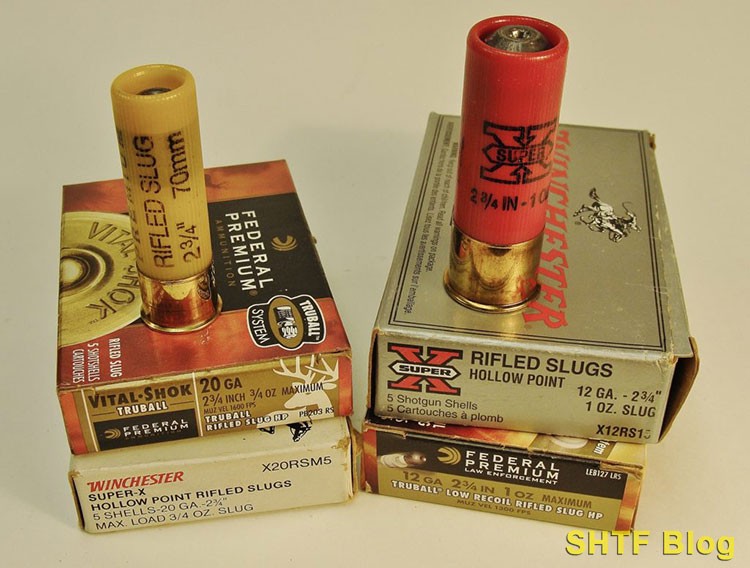
Due to trajectory and the effects of wind, 90-100 yards is a realistic maximum range. We sight in at 50 yards and then scribe a witness line on the rear sight. Next, a thin layer of thread-sealer is applied to the ramp. The upper sliding sight assembly is then repositioned and firmly screwed in place to eliminate recoil-induced creep.
Buckshot Notes
You’ll find with a 50-yard slug zero, most 00 Buck loads will be on the money within their useful range. Most of the rifle-sighted slug barrels employ a fixed IC choke so patterns can run a bit more open, limiting use (on deer) to around 35 yards – with 9-pellet 2 ¾” loads yards.
While you could step up to 12-pellet 3” Magnums, recoil will increase significantly. Actually, we went in the opposite direction, shooting “low recoil” LE loads that patterned beautifully. The optimum buckshot constriction is often modified-choke, which will still shoot slugs with reasonable accuracy.
While Foster-type slugs can be fired through a full choke, accuracy may degrade and, believe it or not, buckshot patterns could also suffer. So, the fixed IC barrel turns out to be a good general-purpose choice. For defense inside the home, a #6 field load of birdshot can limit penetration.
If somewhat skeptical, fire a pattern at 7 yards to see the impressive result. Better yet, fire every load you choose in low light to observe its muzzle-flash.
Reloaders will want to ask themselves if reloading shotgun shells is worth it.
Two Barrels = Greater Versatility
Consider one of these spare barrels…
Special Purpose 3” Slug Barrel With Interchangeable Chokes
This smoothbore, rifle-sighted version is machined for Rem-Chokes. Its Modified tube will tighten most patterns to gain a few extra yards. Install an extra-tight turkey choke and you’ll have an effective Tom-basher capable of delivering concentrated 3” Magnum doses of #5s – just the ticket for 40-yard or greater head shots.
Special rifled choke tubes are another possibility. We’ve seen some improvement in slug accuracy despite their short length. Some lead will accumulate in the lands and grooves but it’s easy to scrub out once the tube is removed.
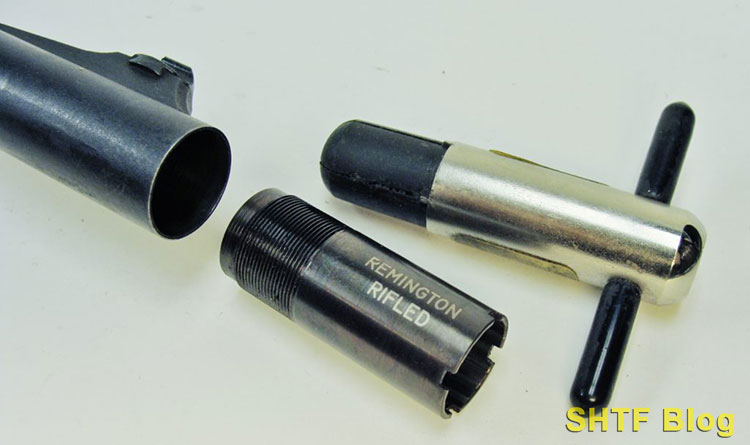
Fully-Rifled Barrel
This type of barrel can often deliver phenomenal accuracy with specialty sabot slugs – on the order of 2” groups or less at 100 yards. A cantilever version has a barrel-mounted scope base that extends back over the receiver.
Mount the right scope with sabots and range can be extended to 150 yards. However, the increased scope height will be better served by some sort of cheek-piece riser – or Remington’s special raised slug stock. By the way, rifling and shot loads don’t mix, resulting in wildly blown patterns. It’s slugs or nothing.
Note: A rifle-sighted barrel won’t serve well for wing-shooting, but it’ll cover most other bases, making it the possible default installation. Zero will be maintained because the sights are on the barrel, and barrel exchanges are easy with the standard magazine-cap.
Maintaining a Remington 870
The magazine cap is also the gateway to cleaning, including tool-less removal of the forend and breech-bolt assembly. The trigger group is captured by two simple pins, permitting periodic removal for cleaning. Choke tube threads should also receive periodic attention to prevent eventual seizing; easy with the supplied wrench.
After shooting slugs, expect buildup of lead in the barrel. It, and any other deposits, can be removed with a bronze brush and Shooter’s Choice solvent, which will also dissolve plastic wad residue. You’ll brush out a surprising amount of lead after shooting slugs, so this process is best done outdoors.
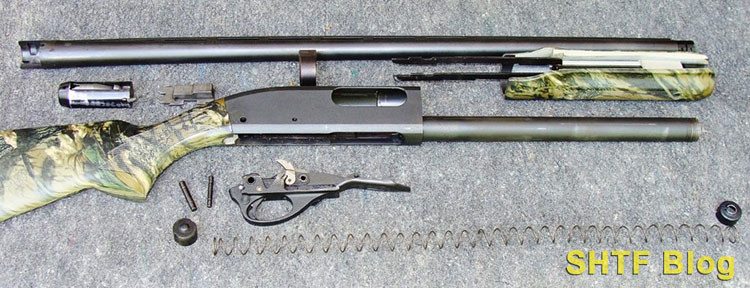
Extended Magazines, Side-Saddle Shell Holders, Etc.
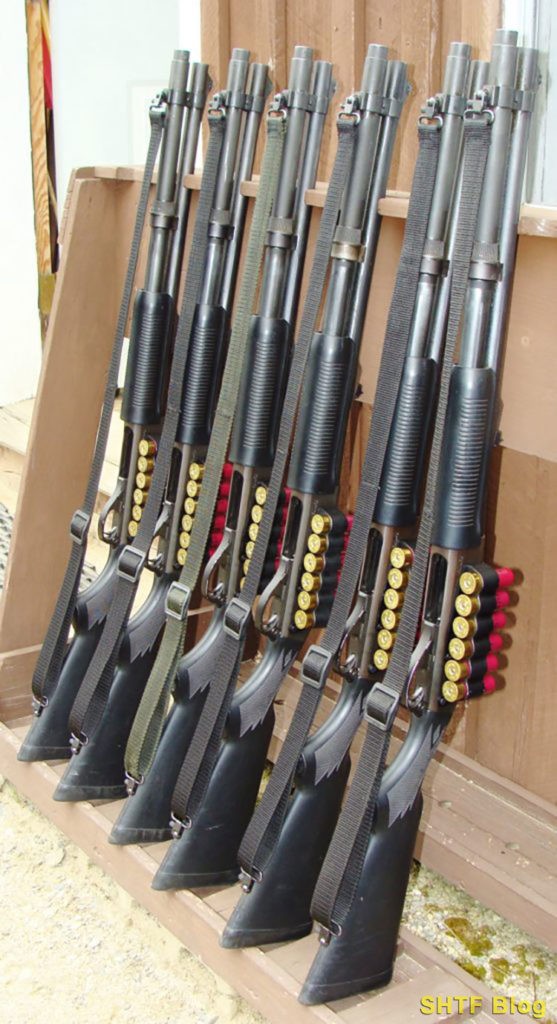
We equipped our M-870 Police guns with extended magazines, increasing capacity to 7 +1. Trouble is, the extension replaces the barrel’s retaining cap, which complicates disassembly. A much longer, energetic magazine spring is also required, along with a supporting barrel bracket that doubles as a sling attachment. Fast barrel changes are out, and routine maintenance is also more complicated.
The standard sporting M-870 has a 4 +1 capacity and the magazine spring is captured by a retainer during removal of the cap. An older springy press-fit collar design worked, but the newer types may employ a pair of swaged dimples in the tube that capture a corresponding plastic plug (removed after rotating it 90 degrees).
Either is fine for sporting purposes and actually, since Federal waterfowl regulations limit capacity to 2 +1, you’ll need to add a magazine limiting plug. Going in the opposite direction, adding an extension to a swaged type is problematic because the recesses must be removed before shells can pass through. So, for many folks, the sporting arrangement keeps things simpler.
As for receiver-mounted shell carriers, most mount via two cross-pins that replace the factory trigger-group retaining pins. Fire-control servicing becomes more complicated, and the shells are more exposed to weather.
Defensive Alternatives
Besides increased maintenance hassles, the above additions add lots of extra weight, resulting in a gun that handles like a truck-axle. Smaller-statured shooters will struggle. As an alternative, learn to run the gun on your shoulder and program yourself to sustain-load its magazine!
This “shoot & replace” strategy will largely mitigate capacity limitations and you won’t run dry; something that can’t be said of a detachable-magazine firearm. Granted, the latter affords ammo management advantages, but KISS is also good. Go that route and you’ll only need a few extra dollars for a QD sling and a gun case.

Purpose-built Guns
Some shoppers won’t be interested in any wing-shooting capability, which opens the door to more exotic configurations. One that bridges the gap is Remington’s 12 Ga. M-870 Express Tactical, factory-equipped with an extended 6 +1 magazine, and ghost-ring receiver sight/scope base.
This aiming system is fast and more accurate than standard open rifle sights. Its 18 ½” barrel has a ramped front sight, and comes with a ported IC Rem-choke ideal for defense, deer, or hogs. Since extra tubes can handle other game like turkeys, this gun can cover lots of bases.
In fact, other makers now sell similar versions. Specialized guns like chopped, quasi-pistol Shockwaves, are best-suited for a fight in an elevator. Overall, you’re much better off with a stock.
Autos?
Actually, I’m a semiauto fan, heavily into Berettas. But, the main considerations here are affordability and versatility. This explains the absence of other great autoloaders from Benelli, etc., which retail for much more. Also, a run-of-the-mill manually-operated pump-gun will digest just about any shell you can toss in it.
Conclusion
If I could only have one gun it would be as 12 gauge pump shotgun, set up with two barrels as described above. Sexy? No, but practical – and also legal everywhere! Again, a basic pump (like a M-870 Express) can provide a useful starting point.
It can also serve as “take-down gun” for storage in smaller spaces. And, with lots of extra barrels in circulation (both new or used), a spare won’t break the bank. But, again, there are other good choices. Mossberg makes good shotguns and their Flex System is worth a look.
For more information on shotguns including details about chokes, patterns, shot-sizes, and guns, check out Shotguns: A Comprehensive Guide, available through Amazon.
- Amazon Kindle Edition
- Markwith, Steve (Author)

